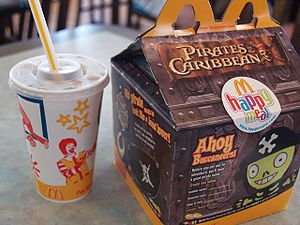Parents around the country are concerned about the continued rise in the rate of childhood obesity and worry about what they need to do to help their children make healthy choices in a world that doesn’t often make that easy to do. In recent months, local and city governments in California and other states have decided that relying on parents to help their children learn to make the right choices isn’t enough and have passed ordinances that ban fast food promotions targeted at children. In San Francisco, an ordinance makes it illegal to include any incentive, like the popular toys found in McDonald’s Happy Meals, in any meal marketed for children that exceeds a specific amount of fat and calories.
In an effort to head-off these types of ordinances, the Arizona legislature passed HB 240 which will go into effect July 20, 2011. This law prohibits local governments within the state from imposing regulations that limit the right of local businesses to offer incentives that appeal to children including toys, crayons, placemats, coupons, and games. The aim of the law is to protect free enterprise and to limit government intrusion into the lives of Arizona residents. On the childhood obesity front, the Arizona lawmakers prefer to leave the responsibility for raising healthy children in the hands of their parents is a good idea.
So what can you, as a parent do, to help your children learn healthy habits and make healthy food choices? Get them involved and give them opportunities to make healthy choices. Here are 5 tips to help you to help your children develop healthy habits that will last a lifetime.
1. Get Them Involved
One of the best ways to help your children develop healthy attitudes about food is to involve them in more ways than just asking if they want something special at the store or which fast food restaurant they want dinner from. Give them the opportunity to plan a dinner each week. Let them find the recipe, make the shopping list, and help with the shopping and preparation. Getting your children involved in menu planning gives them a foundational understanding of what constitutes a healthy, well-balanced meal and how to go from a menu to a meal.
2. Get Them Moving
In the 21st Century, we live more sedentary lives. Have your children spend more time outside. Limit their time on the computer playing games. In fact, if your child’s interest are more around video games and high-tech stuff, make sure he has some kind of extra-curricular activity that is sports or outdoor related. The key is to get their heart rate up and to burn calories.
3. Get Them Planting
Start a backyard garden with your children. Or, a simple tray of herbs can inspired their understanding of food. Don’t garden? All of our county extension services have master gardener programs. Even if it’s just a few vegetable plants, when a child grows their own, they want to try them.
4. Get Them Connected
One of the unhealthiest eating habits Americans struggle with is eating for the wrong reasons including emotions, comfort, stress, and even boredom. To help your children develop a healthy attitude about food, get them connected to why we eat and why the food we eat matters. Food is our fuel and remembering that is one of the keys to developing a healthy lifestyle.
5. Get Them to the Source
Build your child’s food intelligence by taking a family trip to a local farm to see how food is grown, where milk and eggs come from, and how farmers help provide the key ingredients for a healthy meal. Visit a farm stand or the local farmer’s market to learn how to pick a good watermelon and how many different kinds of leafy greens you can use to make a salad. Spend an afternoon at a local farm where they let you pick your own apples or berries so your children can connect to the source of their food.
6. Give them Choices
Today’s families are always on the go and one of the reasons that salty, sugary snacks and drive-thru kid’s meals have become such a staple of many children’s diets is that they are fast and easy. Empower your children, and yourselves to make healthy choices by making them just as fast and easy. Put together snack packs of carrots and celery or a mix of berries in snack size plastic bags and then keep them where your children can reach them in the fridge. Fill your pantry with healthier alternatives to traditional after school snacks that are split into individual serving sizes. Prepare a few dinners ahead of time and freeze them to ensure you always have a quick, home cooked meal on hand even when you are short on time. Make it easy to make healthy choices.
7. Give them a Good Example
The most important thing parents can do to help their children build healthy eating habits, is to be a good role model. Instead of reaching for the bag of chips, crunch some carrots or a fresh apple. Skip the soda and have a cold glass of milk. If you want your children to have a healthy attitude about food and make healthy choices, you need to show them how and lead by example.
Whether there are toys in Happy Meals or not, the bottom line is that parents are in control of the food their children eat and the habits they develop. Give them the best start at a long healthy life by getting them involved and giving them the knowledge and experience they need to make healthy choices.
Related articles
- 6 Money Saving Tips for Healthy Eating (fillyourplate.org)
- Rising Food Prices II: How to Manage Your Food Budget (fillyourplate.org)
- Fresh Arizona Fruit: More than Just Desserts (fillyourplate.org)



Pingback: 5 Reasons You Should Be Happy Supermarkets Aren’t Run Like Schools | Fill Your Plate Blog